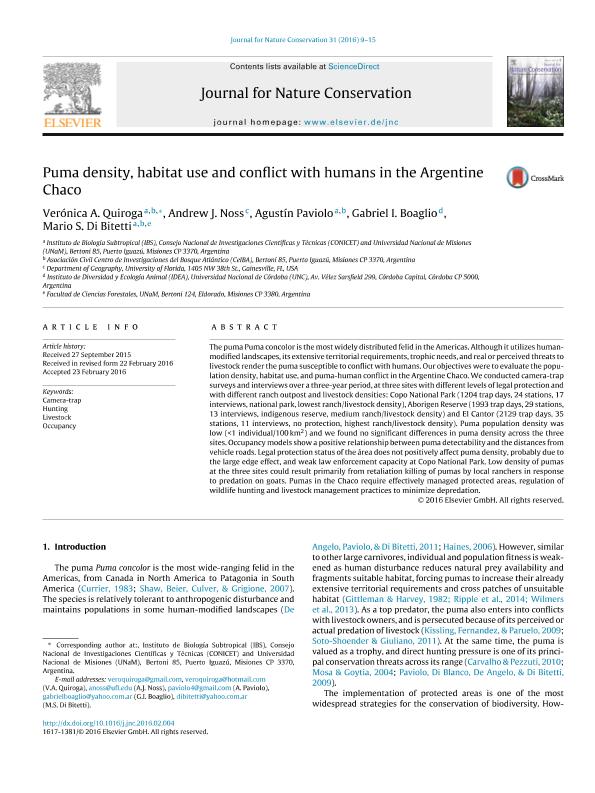Artículo
Puma density, habitat use and conflict with humans in the Argentine Chaco
Quiroga, Verónica Andrea ; Noss, Andrew; Paviolo, Agustin Javier
; Noss, Andrew; Paviolo, Agustin Javier ; Boaglio, Gabriel Ivan
; Boaglio, Gabriel Ivan ; Di Bitetti, Mario Santiago
; Di Bitetti, Mario Santiago
 ; Noss, Andrew; Paviolo, Agustin Javier
; Noss, Andrew; Paviolo, Agustin Javier ; Boaglio, Gabriel Ivan
; Boaglio, Gabriel Ivan ; Di Bitetti, Mario Santiago
; Di Bitetti, Mario Santiago
Fecha de publicación:
02/2016
Editorial:
Elsevier Gmbh
Revista:
Journal For Nature Conservation
ISSN:
1617-1381
e-ISSN:
1618-1093
Idioma:
Inglés
Tipo de recurso:
Artículo publicado
Clasificación temática:
Resumen
The puma Puma concolor is the most widely distributed felid in the Americas. Although it utilizes human-modified landscapes, its extensive territorial requirements, trophic needs, and real or perceived threats tolivestock render the puma susceptible to conflict with humans. Our objectives were to evaluate the popu-lation density, habitat use, and puma-human conflict in the Argentine Chaco. We conducted camera-trapsurveys and interviews over a three-year period, at three sites with different levels of legal protection andwith different ranch outpost and livestock densities: Copo National Park (1204 trap days, 24 stations, 17 interviews, national park, lowest ranch/livestock density), Aborigen Reserve (1993 trap days, 29 stations,13 interviews, indigenous reserve, medium ranch/livestock density) and El Cantor (2129 trap days, 35stations, 11 interviews, no protection, highest ranch/livestock density). Puma population density waslow (<1 individual/100 km2) and we found no significant differences in puma density across the threesites. Occupancy models show a positive relationship between puma detectability and the distances fromvehicle roads. Legal protection status of the área does not positively affect puma density, probably due tothe large edge effect, and weak law enforcement capacity at Copo National Park. Low density of pumasat the three sites could result primarily from retaliation killing of pumas by local ranchers in responseto predation on goats. Pumas in the Chaco require effectively managed protected areas, regulation ofwildlife hunting and livestock management practices to minimize depredation.
Palabras clave:
Camera-Trap
,
Hunting
,
Livestock
,
Occupancy
Archivos asociados
Licencia
Identificadores
Colecciones
Articulos(IBS)
Articulos de INSTITUTO DE BIOLOGIA SUBTROPICAL
Articulos de INSTITUTO DE BIOLOGIA SUBTROPICAL
Articulos(IDEA)
Articulos de INSTITUTO DE DIVERSIDAD Y ECOLOGIA ANIMAL
Articulos de INSTITUTO DE DIVERSIDAD Y ECOLOGIA ANIMAL
Citación
Quiroga, Verónica Andrea; Noss, Andrew; Paviolo, Agustin Javier; Boaglio, Gabriel Ivan; Di Bitetti, Mario Santiago; Puma density, habitat use and conflict with humans in the Argentine Chaco; Elsevier Gmbh; Journal For Nature Conservation; 31; 2-2016; 9-15
Compartir
Altmétricas



